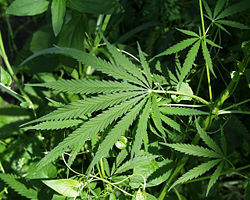Cannabis sativa
| Cannabis sativa | ||||||||||||||
|---|---|---|---|---|---|---|---|---|---|---|---|---|---|---|
 |
||||||||||||||
| Scientific classification | ||||||||||||||
|
||||||||||||||
| Binomial name | ||||||||||||||
| Cannabis sativa Linnaeus |
||||||||||||||
| Subspecies | ||||||||||||||
|
C. sativa L. subsp. sativa |
Cannabis sativa is an annual plant in the Cannabaceae family. It is a herb that has been used throughout recorded history by humans for various purposes such as fiber, as a drug (see cannabis (drug)), as medicine (see medicinal cannabis), for oil and as food. Different parts of the plant have different uses, and different varieties are cultivated in different ways and harvested at different times, depending on the purpose for which it is grown.
Contents |
Species, subspecies, and varieties

The following taxonomic treatment of Cannabis was published in 1976 by Ernest Small and Arthur Cronquist.[1] Other taxonomic treatments of Cannabis are valid, and utilized by some botanists.
- Cannabis
- Cannabis sativa L.
- C. sativa subsp. sativa
- C. sativa subsp. sativa var. sativa
- C. sativa subsp. sativa var. spontanea
- C. sativa subsp. indica
- C. sativa subsp. indica var. indica
- C. sativa subsp. indica var. kafiristanica
- C. sativa subsp. sativa
- Cannabis sativa L.
C. sativa subsp. sativa
C. sativa subsp. sativa var. sativa
Correct name: Cannabis sativa L. subsp. sativa var. sativa
This taxon includes two types of Cannabis cultivated for drug production,[1] commonly referred to by Cannabis aficionados as "sativa" and "indica".
This taxon includes hemp landraces and cultivars grown for fiber or seed production. Fiber strains are usually tall and unbranched. Seed strains are often shorter, and may be branched or unbranched. Some strains are monoecious. Plants of certified industrial hemp strains produce a relatively high ratio of CBD to THC (about 20:1), and are not suitable for drug use.[1][2][3]
C. sativa subsp. sativa var. spontanea

Correct name: Cannabis sativa L. subsp. sativa var. spontanea (Vavilov) Small & Cronq.
Synonym: C. ruderalis Janisch.
This taxon includes wild or feral Cannabis plants. In the absence of selective breeding, these plants have lost many of the traits they were originally selected for, and have acclimatized to their locales. Plants of this type are often short, branchless, and early-flowering. The plants usually have low levels of cannabinoids, and a low ratio of THC to CBD, and thus are of little use as a source of drugs.[3] However, so-called "indica" drug strains are sometimes cross-bred with "ruderalis" to produce high THC plants having the hardiness and reduced height of "ruderalis".
The term "ruderal" was originally used in the former Soviet Union to describe populations of hemp that had escaped cultivation and adapted to the surrounding region. Plants of this type are widespread throughout central and eastern Europe, including Lithuania, Belarus, Latvia, and Estonia. Similar populations can be found in most of the areas where hemp cultivation was once prevalent. The most notable region in North America is the Midwest, though populations occur sporadically throughout the United States and Canada. These plants have escaped from cultivation more recently, and often grow larger than the ruderal plants in Europe.
Cannabis users often call this feral Cannabis "ditch weed." Outside of its native range, it is regarded as an invasive plant. Despite years of government-sponsored eradication programs, these feral plants still remain in bountiful abundance.
It has several times been proposed that this taxon be recognized as a distinct species, called C. ruderalis.[4]
C. sativa subsp. indica
C. sativa subsp. indica var. indica

Correct name: Cannabis sativa L. subsp. indica (Lam.) Small & Cronq. var. indica (Lam.) Wehmer
Synonym: C. indica Lam.
Some users report that highs from "sativa" strains tend to produce clearer, cerebral "head" highs, whereas highs from "indica" strains produce more lethargic "body" highs, with emphasis on drowsiness, and increase appetite ("munchies"). To date, no undisputable chemical or pharmacological basis for these differing effects has been discovered. Anecdotal evidence suggest that variations in the amount of cannabidiol (CBD) may be a factor.
It has often been proposed that this taxon be recognized as a distinct species, C. indica. Most recently, on the basis of genetic, morphological, and chemotaxonomic analyses, Hillig assigned both the narrow-leaflet and wide-leaflet drug "biotypes", as well as southern and eastern Asian hemp (fiber/seed) landraces and wild Himalayan populations, to C. indica.[5][3][6]
C. sativa subsp. indica var. kafiristanica

Correct name: Cannabis sativa L. subsp. indica (Lam.) Small & Cronq. var. kafiristanica (Vavilov) Small & Cronq. Synonym: C. indica Lam. var. kafiristanica Vavilov.
This taxon includes wild or feral plants, mostly confined to the Indian subcontinent and other regions where Cannabis is grown for drug use and has escaped from cultivation. Individual plants may have low, similar, or high levels of THC relative to CBD. Plants with relatively high levels of Δ9-tetrahydrocannabidivarin (THCV) and/or cannabidivarin (CBDV) are also common in this group.[3] Compared with wild or feral plants of var. spontanea, plants of this taxon are often taller and more branched. The achenes are usually very small. The inflorescenses of pistillate plants are often elongated, and the fruits (achenes) drop off the plants as they mature.
Common uses
The tough fiber of the plant, cultivated as hemp, has numerous textile uses. Its seed, chiefly used as caged-bird feed, is a valuable source of protein. The flowers (and to a lesser extent the leaves, stems, and seeds) contain psychoactive and physiologically active chemical compounds known as cannabinoids that are consumed for recreational, medicinal, and spiritual purposes. When so used, preparations of flowers (marijuana) and leaves and preparations derived from resinous extract (hashish) are consumed by smoking, vaporizing and oral ingestion. Historically, tinctures, teas, and ointments have also been common preparations. In the north and western part of Sumatra, Indonesia, the young leaves were eaten raw as salad, however it was illegal to consume this plant as dried product.
Plant physiology

Cannabis reproduces sexually. The flowers of the female plant are arranged in racemes and can produce hundreds of seeds. Male plants shed their pollen and die several weeks prior to seed ripening on the female plants. Although genetic factors dispose a plant to become male or female, environmental factors including the diurnal light cycle can alter sexual expression. Naturally occurring monoecious plants, with both male and female parts, are either sterile or fertile but artificially induced "hermaphrodites" (a commonly used misnomer) can have fully functional reproductive organs. "Feminized" seed sold by many commercial seed suppliers are derived from artificially "hermaphrodytic" females that lack the male gene, or by treating the seeds with hormones or silver thiosulfate.
A Cannabis plant in the vegetative growth phase of its life requires more than 12-13 hours of light per day to stay vegetative. Flowering usually occurs when darkness equals at least 12 hours per day. The flowering cycle can last anywhere between five to ten weeks, depending on the strain and environmental conditions.
In soil, the optimum pH for the plant is 6.5 to 7.2. In hydroponic growing, the nutrient solution is best at 5.2 to 5.8, making Cannabis well-suited to hydroponics because this pH range is hostile to most bacteria and fungi.
- Cultivars primarily cultivated for their fiber, characterized by long stems and little branching.
- Cultivars grown for seed from which hemp oil is extracted.
- Cultivars grown for medicinal or recreational purposes. A nominal if not legal distinction is often made between industrial hemp, with concentrations of psychoactive compounds far too low to be useful for that purpose, and marijuana.
Pharmacology

Although the main psychoactive chemical compound in Cannabis is Δ9-tetrahydrocannabinol (THC), the plant is known to contain about sixty cannabinoids; however, most of these "minor" cannabinoids are only produced in trace amounts. Besides THC, another cannabinoid produced in high concentrations by some plants is cannabidiol (CBD), which is not psychoactive but has recently been shown to block the effect of THC in the nervous system.[7] Differences in the chemical composition of Cannabis varieties may produce different effects in humans. Synthetic THC, called dronabinol, does not contain CBD, CBN, or other cannabinoids, which is one reason why its pharmacological effects may differ significantly from those of natural Cannabis preparations.
Chemical constituents
Cannabis has over 400 chemical constituents including about 100 compounds responsible for its characteristic aroma (see Cannabis flower essential oil). These are mainly volatile terpenes and sesquiterpenes.
- Δ9-Tetrahydrocannabinol
- α-Pinene[8]
- Myrcene[8]
- Trans-β-ocimene[8]
- α-Terpinolene[8]
- Trans-caryophyllene[8]
- α-Humulene,[8] contributes to the characteristic aroma of Cannabis sativa
- Caryophyllene-oxide,[8] with which some hashish detection dogs are trained[9]
Gallery of images
See also
- Cannabis (drug)
- Cannabis flower essential oil
- Hemp
- Medical cannabis
References
- ↑ 1.0 1.1 1.2 Small, E. and A. Cronquist. 1976. A practical and natural taxonomy for Cannabis. Taxon 25(4): 405–435.
- ↑ de Meijer, E. P. M. 1999. Cannabis germplasm resources. In: Ranalli P. (ed.). Advances in Hemp Research, Haworth Press, Binghamton, NY, pp. 131-151.
- ↑ 3.0 3.1 3.2 3.3 Hillig, Karl W. and Paul G. Mahlberg. 2004. A chemotaxonomic analysis of cannabinoid variation in Cannabis (Cannabaceae). American Journal of Botany 91(6): 966-975. Retrieved on 22 February 2007
- ↑ Schultes, R. E., /www.bio.fsu.edu/faculty-anderson.php Anderson, L. C.] 1980. Leaf variation among Cannabis species from a controlled garden. Harvard University Botanical Museum Leaflets 28: 61–69. Retrieved on 23 February 2007
- ↑ Hillig, Karl W. 2005. Genetic evidence for speciation in Cannabis (Cannabaceae). Genetic Resources and Crop Evolution 52(2): 161-180. Retrieved on 23 February 2007
- ↑ Hillig, Karl William. 2005. A systematic investigation of Cannabis. Doctoral Dissertation. Department of Biology, Indiana University. Bloomington, Indiana. Published by UMI. Retrieved on 25 February 2007
- ↑ West, D. P, Ph.D. 1998. Hemp and Marijuana: Myths & Realities. North American Industrial Hemp Council. Retrieved on 23 April 2007
- ↑ 8.0 8.1 8.2 8.3 8.4 8.5 8.6 J. Novak, K. Zitterl-Eglseer, S. G. Deans, and C. M. Franz. "Essential oils of different cultivars of Cannabis sativa L. and their antimicrobial activity", Flavour and Fragrance Journal 16 (4):259-262, 2001.
- ↑ Essential Oils
External links
|
||||||||||||||||||||